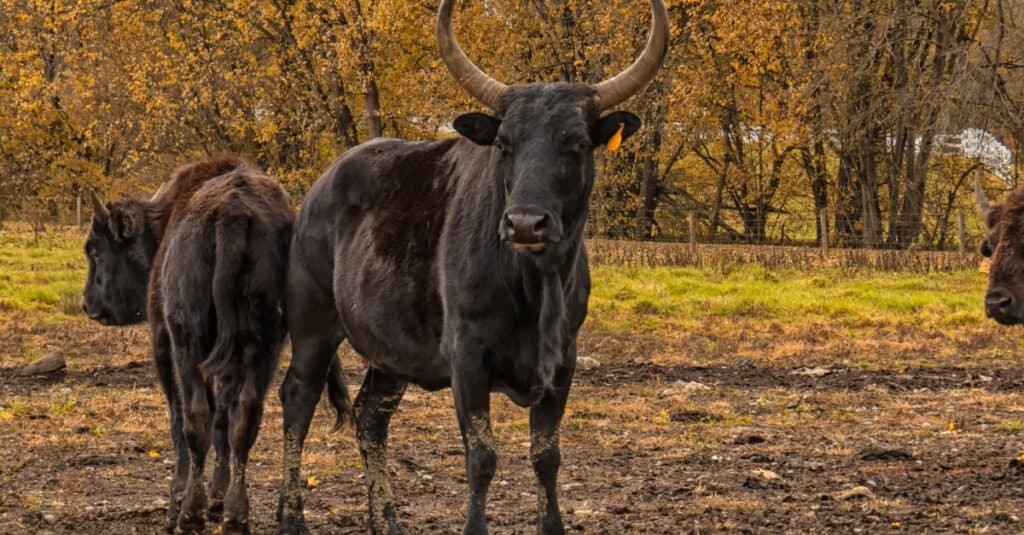Beefalo
.jumbotron {
background-image: url(“https://a-z-animals.com/media/2021/07/Beefalo-in-the-fall-header-400×300.jpg”);
}
}
@media only screen and (min-width: 641px) and (max-width: 920px) {
.jumbotron {
background-image: url(“https://a-z-animals.com/media/2021/07/Beefalo-in-the-fall-header-470×370.jpg”);
}
}
@media only screen and (min-width: 921px) {
.jumbotron {
background-image: url(“https://a-z-animals.com/media/2021/07/Beefalo-in-the-fall-header.jpg”);
}
}
Beefalo meat is leaner and higher in protein than beef
Beefalo Scientific Classification
- Kingdom
- Animalia
- Phylum
- Chordata
- Class
- Mammalia
- Order
- Artiodactyla
- Family
- Bovidae
- Genus
- Bos x Bison
- Scientific Name
- Bos taurus × Bison bison
Read our Complete Guide to Classification of Animals.
Beefalo Conservation Status
Beefalo Facts
- Name Of Young
- Calf
- Group Behavior
-
- Herd
- Fun Fact
- Beefalo meat is leaner and higher in protein than beef
- Estimated Population Size
- Unknown
- Biggest Threat
- Lack of fertile hybrid bulls
- Distinctive Feature
- Looks like cattle but is hardier physically and health-wise
- Other Name(s)
- Cattalo
- Gestation Period
- 283 days
- Litter Size
- 1
- Habitat
- Farms
- Predators
- Humans
- Diet
- Herbivore
- Type
- Bovid
- Common Name
- Beefalo
- Number Of Species
- 1
- Location
- North America
- Group
- Herd
Beefalo Physical Characteristics
- Color
-
- Fawn
- Red
- Black
- Skin Type
- Hair
- Lifespan
- 25
- Weight
- 900-2,000 pounds
- Height
- 4.6 ft
- Age of Sexual Maturity
- 6-15 months
- Age of Weaning
- 205 days
This post may contain affiliate links to our partners like Chewy, Amazon, and others. Purchasing through these helps us further the A-Z Animals mission to educate about the world’s species..

Spiders that fly! Fish that walk! And 1000+ more incredible animals. Discover them all for FREE
.photo-gallery {
–margin: 0px auto 0px;
–padding: 0px 0px 0px 0px;
}
.gallery-link {
background-image: url(“https://a-z-animals.com/media/2021/07/Beefalo-in-the-fall-1024×535.jpg”);
background-repeat: no-repeat;
background-size: cover;
background-position: center;
height: 500px;
justify-content: center;
text-align: center;
align-items: center;
display: flex;
border: 2px solid #000;
}
.gallery-link img {
height: 50%;
}
@media only screen and (max-width: 768px) {
.gallery-link {
height: 300px !important;
}
}
View all of the Beefalo images!
Beefalo are the fertile offspring of (usually) a domestic bull and an American bison cow. While crossing a domestic cow and a bison bull can produce offspring, they are few in number.
The beefalo is a fertile hybrid of beef cattle and American bison (buffalo), with the result being mostly cattle in appearance and genetics. Its origin was the cattalo of Charles “Buffalo” Jones who created the first bison hybrid. The intention was to make hardier cattle to survive harsh winters as well as to preserve bison, most of which today have a small percentage of cattle genes. Beefalo color takes after the cattle which can be any of the breeds used for the crossing, and the result is better milk than that of the bison and meat which is leaner than that of beef.
4 Incredible Beefalo Facts!
- Full Beefalo must have exactly 3/8 American bison genetics; if higher, it’s a bison hybrid.
- The origin of the Beefalo was the first fertile hybrid bull from a domestic bull and an American bison cow, which produced several offspring with fertile females but rarely-fertile males.
- Beefalo meat is lower in calories, fat, cholesterol and saturated fat and higher in protein than beef.
- The origin of hybrid bovids was in 1749 with the accidental crosses of cattle and American bison in the southern United States, but intentional crosses began in the mid-19th century.
Beefalo Scientific Name
The scientific name for Beefalo is Bos taurus × Bison bison. Like both domestic cattle and American bison (buffalo), it is in the family Bovidae, subfamily Bovinae, tribe Bovini, and subtribe Bovina. Domestic cattle are Bos taurus and American bison are Bison bison, with subtribe Bovina containing the two living genera Bos and Bison. Bos is the genera for wild and domestic cattle and contains 5 species, while the genera Bison contains 6 extinct and 2 extant species. Although American bison and domestic cattle are from both a different genus and a different species, they have enough genetic similarities for several domestic cattle breeds to produce fertile offspring with American bison.
Beefalo Appearance
Beefalo can come in a variety of colors, with the color taking after the domestic cattle used to cross with the American bison. There is no standard color, but a dark black/red to light fawn is common. Its size and appearance resemble the cattle while the cattle also predominates its genetics, weighing 900 to 2,000 pounds and reaching up to 55 inches in height. It is classified as a USDA-recognized cattle breed and is different from a Bison Hybrid or Cattalo, which both have more American bison genetics. Hereford, Angus, and Holstein cattle are common in crossing with bison, but the cattle parent can also be a mix of different breeds, including breeds from other countries, in order to promote genetic diversity.
Beefaloes differ from bison in that they lack the hump. They have fine, dark hair evenly covering their bodies. Bison are hairier and have curved, larger horns, but beefaloes may be either horned or polled. If they are horned, the horns are long, tapering, and pointed upwards.

Mark Spearman / flickr – License
Beefalo Behavior
The behavior of American bison-cattle hybrids depends on the amount of bison genetics they contain. For beefalo, they are most similar to cattle in appearance, behavior, and genetics. If they further interbreed with American bison, the resulting offspring will behave more like the bison parent. Bison are more aggressive than cattle and wander more, whereas cattle stay around trees and water sources. Beefalo are more docile and have about 12 members in a herd. Whereas bison naturally group together cows and calves with bulls in a separate herd, beefalo farmers separate bulls from cows and calves until breeding time. The breed of domestic cattle parent the beefalo can also determine behavior, as heavier milk cattle are dominant to lighter milk breeds, and lighter meat cattle are dominant to heavier meat breeds.
Beefalo Habitat
Beefaloes live in North America. However, they are only available from farmers registered with the American Beefalo Association. Although they originated in Kansas, which has extremely cold winters, they can handle both extreme heat and cold.
Beefalo Diet
Unlike cattle, beefaloes need little to no grain feeding. They can survive on a wide variety of grasses in both very hot and very cold weather and less grass than cattle, making them ideal for both harsh weather and rough or weathered vegetation.
Beefalo Predators and Threats
The beefalo is far hardier and disease-resistant than domestic cattle, being resistant to Bovine Viral Diarrhea, Bovine Respiratory Complex, and Blackleg. They do not need to be vaccinated as often as cattle, either. Humans are its only natural predators as they developed the beefalo under-managed breeding programs for consumption of milk and meat and use of manure.
Beefalo Reproduction and Life Cycle
The beefalo parents of American bison and cattle are bred in managed breeding programs to create hybrid offspring. Fertile cow hybrids are then bred with fertile bull hybrids.
Beefalo can be produced naturally or artificially (via insemination or insertion of a fertilized embryo). The gestation period is between 279 to 287 days with an average of 283 days, with bull calves having gestation periods that are a little longer than heifer calves. Beefalo calves are very small after being born and weigh an average of 40 to 60 pounds, but grow to weigh 800 to 1,000 pounds at 9 to 12 months instead of the 12 to 14 months of the cattle. They reach sexual maturity a little later than domestic cattle while being able to reproduce until 25 years of age compared to 8 to 10 years. Beefalo calves are weaned at 205 days and reach sexual maturity within 6 to 15 months.
Unlike cattle, beefaloes have no calving problems and they grow faster, needing no growth hormones thanks to the bison genetics. They also produce more and richer milk than either cattle or bison, being richer in butterfat and with a sweeter, creamier taste. Their meat is also just as flavorful and tender, making them equally good for milk and meat.
Cattle can live up to 25 years and bison can live up to 20 years. The beefalo’s lifespan is at least 20 years, with its hardiness making it likely to live 25 years or more.
Beefalo Population
Beefalos are considered an invasive species as they behave more like cattle and can pollute water sources, negatively affecting biodiversity and the cleanliness of their environments. They can also naturally cross with bison to create more aggressive bovid hybrids and pollute the gene pool of the few remaining pure bison herds.
View all 192 animals that start with B
Beefalo FAQs (Frequently Asked Questions)
What is a beefalo?
Beefalo are fertile hybrid crosses between domestic cattle and American bison with no more and no less than 3/8 bison genetics and 5/8 cattle genetics. Note that in the United States, a cattalo is an American bison-cattle hybrid that looks like bison, while in Canada it refers to all bison-cattle hybrids. If a Beefalo has less than 3/8 bison genetics, it’s an American Breed; if more, it’s a Bovid Hybrid.
Is beefalo meat good?
Yes, beefalo meat is good, tasty, and healthy. It has the best of both worlds from beef and bison meat. Cooking is faster than with beef due to containing less fat.
Can beefalo reproduce?
Yes, Beefalo can reproduce. The fertile offspring were originally usually female, but the development of the Beefalo began with the first fertile bull hybrid, which was needed to continue the new species with fertile cow hybrids. While a male bison crossed with a domestic cow creates few offspring, crossing a domestic bull with a bison cow creates several. However, the female hybrids tend to be fertile more so than the males.
What is the difference between a buffalo and a beefalo?
Buffalo, also called American buffalo, bison, or American bison, are very different from the water buffalo in South Asia and Africa. Beefalo are crosses of American bison with domestic cattle, and both Buffalo and Beefalo live in North America, while buffalo also live in Europe.
How much do beefalo cost?
The price to purchase a beefalo depends on the sex and age of the beefalo and the breed of the cattle parent. However, the price can be anywhere from $1,600 to $3,000. The price of a calf depends on its weight, with the final cost being the total price per pound.
Sources
- Wikipedia, Available here: https://en.wikipedia.org/wiki/Beefalo
- Post Register Intermountain Farm & Ranch, Available here: https://www.postregister.com/farmandranch/columnists/barnyard_basics/barnyard-basics-cattalo-or-beefalo-bison-crossbreeding/article_4806af20-efb4-5cd3-a5b4-9106df9280ba.html
- American Beefalo Association, Available here: http://americanbeefaloassociation.com/
- American Beefalo Association, Available here: http://americanbeefaloassociation.com/benefits
- Beefalo Meats, Available here: https://beefalomeats.com/
- Wikipedia, Available here: https://en.wikipedia.org/wiki/American_bison
- Meyer Buffalo Farm, Available here: https://www.meyerbuffalofarm.com/beefalo-cooking-instructions.html
- Millington Beefalo, Available here: https://millingtonbeefalo.com/cooking-tips
- Macro Evolution, Available here: http://www.macroevolution.net/bison-cattle-hybrids.html
- Soft Schools, Available here: https://www.softschools.com/facts/hybrid_animals/beefalo_facts/2695/
- All Things Nature, Available here: https://www.allthingsnature.org/what-is-a-beefalo.htm
- Modern Farmer, Available here: https://modernfarmer.com/2016/09/beefalo/
- Ned Hardy, Available here: https://nedhardy.com/2020/03/26/why-was-the-beefalo-created/
- Visually, Available here: https://visual.ly/community/Infographics/animals/bison-vs-buffalo
- Flight Path Farms, Available here: http://www.flightpathfarms.com/beefalo/
- Slo Poke Pastures, Available here: https://slopokebeefalo.com/what-is-beefalo-2/
- Macroevolution, Available here: http://www.macroevolution.net/bison-cattle-hybrids.html
- Western Watershed Project, Available here: https://www.westernwatersheds.org/gw-cattle-v-bison/
- Modern Farmer, Available here: https://modernfarmer.com/2016/09/bison-vs-cattle-environment/
- Domestic Animal Breeds, Available here: https://domesticanimalbreeds.com/beefalo-cattle-breed-everything-you-need-to-know/
- Folio 3 Animal Care Practice, Available here: https://animalcare.folio3.com/how-much-does-a-cow-cost-in-usa/
- AgriSeek, Available here: https://www.agriseek.com/s/Beefalo-For-Sale
- National Park Service, Available here: https://www.nps.gov/articles/15-facts-about-bison.htm
- Sentient Media, Available here: https://sentientmedia.org/how-long-do-cows-live/
















